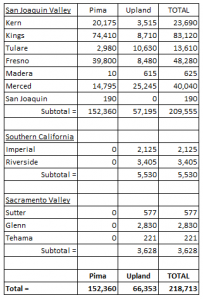October 7, 2016
The California Department of Water Resources provides bi-weekly updates regarding SGM Program information to its stakeholders and interested parties.
State Water Control Board Public Meetings on Fee Schedule
SGMA requires the formation of local groundwater sustainability agencies in California’s high- and medium-priority groundwater basins. Sustainability agencies are required to develop groundwater sustainability plans that will bring basins into sustainability within 20 years of plan implementation. If locals are unable or unwilling to sustainably manage their basin, the State Water Board is authorized to intervene. The State Water Board is required to develop a fee schedule for the purposes of recovering programmatic costs related to implementation of SGMA (Water Code §1529.5). The fee schedule will be adopted through emergency regulation (Water Code §1530). These fees will accompany groundwater extraction reports required to be submitted by groundwater extractors subject to intervention (Water Code §5202).
The State Water Resources Control Board (SWRCB) will be conducting public meetings beginning in October to present the details of their proposed intervention fee schedule and to outline the groundwater extraction reporting requirements for unmanaged areas (Water Code 1529.5 and 5200 et. seq.). The first meeting is October 7, 2016, and the meeting notice is available via this link: http://www.waterboards.ca.gov/water_issues/programs/gmp/docs/fees/100716_sgma_mtg.pdf
The State Water Board is conducting outreach to solicit feedback on the currently proposed fee concepts. The State Water Board has prepared a draft of the fee schedule for discussion purposes. In preparation of the draft concepts, State Water Board staff conducted four stakeholder meetings to solicit preliminary feedback. The purpose of the October 7 meeting will be to provide the general public an opportunity to provide input. The meeting is for the purpose of information gathering only. The feedback provided will be used to inform development of the emergency regulations; the draft regulations will be made available in formal public comment in Spring of 2017.
Groundwater Sustainability Agency (GSA) Formation Notification
DWR reviews and track GSA formation notifications and updates the GSA Interactive Map regularly. The GSA Interactive Map now shows the boundaries of Exclusive GSAs and the statutory boundaries of the exclusive local agencies identified in SGMA.
The entire basin must be covered by one or more GSAs by June 30, 2017, or an Alternative Plan that covers the entire basin must be submitted to DWR by January 1, 2017 in order to avoid potential intervention by the State Water Resources Control Board (Water Code Section 10735.2) If a basin is not entirely covered by one or more GSAs by June 30, 2017, then it will be up to the discretion of the State Water Resources Control Board (SWRCB) to place the entire basin on probation.
DWR published its GSA Formation Notification Guidelines for Local Agencies which outlines the information that must be submitted by a local agency(s) after it decides to become or form a GSA(s). DWR will use these GSA guidelines to perform completeness reviews for all GSA notices filed after January 1, 2016. Only complete GSA formation notices will be posted on DWR’s GSA Formation Table and included on DWR’s GSA Interactive Map.
Contacts:
Mark Nordberg, DWR Sustainable Groundwater Management Program (916) 651-9673, Mark.Nordberg@water.ca.gov. Lauren Hersh, DWR Public Affairs Office (916) 653-2639, Lauren.Hersh@water.ca.gov.
Basin Boundary Modifications
To discuss modification submissions please contact your DWR Region Office Representative:
· Northern Region Office (Red Bluff) – Bill Ehorn, Bill.Ehorn@water.ca.gov
· North Central Region Office (West Sacramento) – Bill Brewster,
Bill.Brewster@water.ca.gov
· South Central Region Office (Fresno) – Dane Mathis, Dane.Mathis@water.ca.gov
· Southern Region Office (Glendale) – Tim Ross, Timothy.Ross@water.ca.gov
Local agencies can locate their respective Region Office Representative by accessing the map-tool here. For more information regarding California’s groundwater basins please visit the Basin Boundary Modifications webpage.
Contacts:
Tim Godwin, DWR Sustainable Groundwater Management Program (916) 651-9223, Timothy.Godwin@water.ca.gov. Lauren Hersh, DWR Public Affairs Office (916) 653-2639, Lauren.Hersh@water.ca.gov.
Facilitation Support Services Available
The Facilitation Support Service Program connects water management groups with professional facilitators to support local public agencies seeking to meet requirements of the Sustainable Groundwater Management Act (SGMA), including forming groundwater sustainability agencies (GSAs) and developing groundwater sustainability plans (GSPs). Facilitation support services from contracted professionals include strategic planning, stakeholder assessments, meeting facilitation, mediation, governance assessment, and public outreach services. Requests for facilitation support services will be evaluated on a regular basis and support will vary based on need and funding availability. DWR continues to accept new applications from local agencies and water management groups for facilitation support services. For more information about applying for Facilitation Support Services, please view the Information for Applicants and Supplemental Information for SGMA Implementation. To discuss applications for Facilitation Support Services, please contact your DWR Region Office Representative:
· Northern Region Office (Red Bluff) – Mary Randall, Mary.Randall@water.ca.gov
· North Central Region Office (West Sacramento) – Hong Lin,
Hong.Lin@water.ca.gov
· South Central Region Office (Fresno) – Charles McKenzie,
Charles.McKenzie@water.ca.gov
· Southern Region Office (Glendale) – Brian Moniz, Brian.Moniz@water.ca.gov
Contacts:
Lauren Hersh, DWR Public Affairs Office (916) 653-2639, Lauren.Hersh@water.ca.gov
Tom Filler, DWR Sustainable Groundwater Management Program (916) 653-5272, Thomas.Filler@water.ca.gov
Water Available for Replenishment (WAFR) Report
SGMA directs DWR to prepare and publish a report on water available for replenishment of groundwater in California by December 31, 2016. DWR has developed a white paper describing concepts, challenges, uncertainties, and a potential technical approach to estimating water available for groundwater replenishment. Public comments are appreciated and those received will help inform the December 2016 WAFR Report. Please email comments to mailto:sgmps@water.ca.gov with the following subject line: Public Comments on WAFR White Paper. For more information visit the website here.
